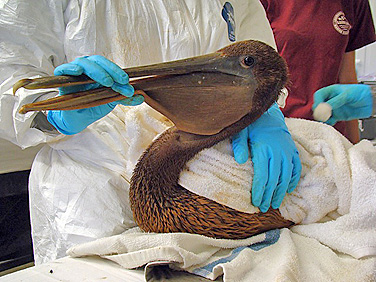News
Impact of Gulf spill impossible
to exaggerate, UB geographer says

The effects from the Gulf oil spill on wildlife, such as this pelican, will be long-lasting and pervasive, UB geographer Charles Ebert says.
The ripple effects from the Gulf of Mexico oil spill will be complex, pervasive and long-lasting, says Charles V. Ebert, a UB geographer whose expertise is in natural and human-induced disasters.
“You cannot exaggerate or overstate the impact of this oil spill,” he says. “It’s a tsunami of bad news.”
Ebert, professor emeritus of geography, authored one of the first textbooks on disasters, “Disasters: An Analysis of Natural and Human-Induced Hazards.” He will teach his signature course this fall that goes by the same name.
According to Ebert, the use of dispersants has enormously increased the area polluted by the oil, both at the surface and at various depths.
“The oil is held in suspension and it moves with ocean currents,” he says. “The greatest danger is to the animals who cannot distinguish between oil and food particles, and they will begin to feed on them.”
This will do massive damage to the next harvest of bluefin tuna, for example, which, Ebert notes, is already an endangered species. He says the tuna larvae likely are feeding on the oil right now since the adult fish come to the Gulf to spawn each spring.
“That’s just one species,” he says. “Many animals depend on nutrients drifting in the water; for example, the algae, phytoplankton and zooplankton. There is massive poisoning going on there right now.”
He notes that bottom feeders, such as shrimp and other shellfish, also will sustain significant damage from the spill.
“It begins with the food chain,” he says. “It’s a chain reaction. If you destroy the first step in it, then you also are destroying the stairway to higher plants and animals. It will be some time before we see the full extent of it in mutations and poisoning. The whole health of the food chain will be destroyed or strongly modified by these toxic materials.”
He notes that any system, including the biosystem of the Gulf of Mexico, is always exposed to some level of stress.
“In the early stages, such systems will adjust to the stress,” he says. “However, if the stress continues, it will reach a critical point, sometimes referred to as the threshold of tolerance, leading to a ‘jump event’ or breakdown.”
Damage will be increased during the hurricane season, as waves and high winds push the oil into sensitive salt marshes and estuaries, he says.
“The salt marshes form a natural barrier against floods and hurricanes,” he says. “They are the spawning grounds for many marine animals, so if they are knocked out as a result of the spill, it will destroy the chain of propagation, preventing new generations of animals. The marsh vegetation works like a filter, assisting in the cleanup of polluted material by absorbing toxic materials, such as heavy metals, from rivers and the ocean. The amount of vegetation that is liable to be lost and the erosion that occurs will be devastating.”
Ebert adds that what distinguishes this oil spill from others is that it has occurred in a densely populated area in an advanced society.
“There are lakes that have been created by oil spills in Siberia that are so large you can see them from space,” he says. “But nobody talks about them because few people are affected by them.
“I hope that this massive oil spill is a wake-up call, not only for this country, but for the world as a whole,” he says.
Ebert’s work on disasters is one component in UB’s strategic strength in Extreme Events: Mitigation and Response identified in the UB 2020 strategic plan to become a model 21st century research university through focused research, growth and transformation of UB’s three campuses.

Reader Comments